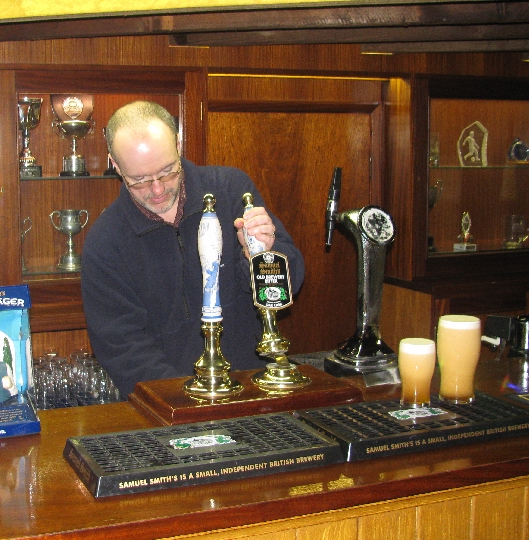|
|
Everyone
understands that fermented grape juice produces wine, but many seem in
the dark regarding the complexities of beer - the world's most popular
alcoholic libation. A complex beverage with a myriad of ingredients,
styles, and methods of serving, beer involves intricacies that often
confound the average consumer. Read on to explore eight popular ale and
lager misconceptions.
Misconception 1: Ales exhibit dark colors, while lagers display yellow or golden hues.
Actually, classifying a beer as an ale or lager has nothing to do with
color, and everything to do with yeast and fermentation temperature.
While lager yeasts love cooler temperatures and impart clean,
non-fruity notes in a brew, ale yeast works best near room temperature
and provides a complex, fruity quality. Terrapin Golden Ale boasts a
lovely light blond color, fruity hints and refreshing drinkability.
Conversely, Samuel Adams Black Lager pours with a deep ebony richness
and clean, chewy, malty mouthfeel.
Misconception 2: Hops come from grain.
Wrong again. Hops are resiny, green flowers from climbing vines
indigenous to Europe. They impart floral, spicy, citrusy aroma, flavor
and bitterness to balance the sweet malt of beer. Hops added to the
brewkettle at the beginning of the boiling process provide bitterness
to beer, while hop additions near the end of the boil add delicate
flavor and aromas. Dry hopping (placing hop flowers directly into a
fermenter or keg) lends the intense hop aroma profile found in
Sweetwater IPA and Stone Brewing's Ruination Pale Ale.
Misconception 3: Light lagers provide health benefits.
Sure, light beers contain the fewest calories of any beer style and
might help melt away a few waistline inches (when combined with
exercise and a low calorie diet), but light beers offer very little
flavor and almost no nutritional value. Darker beers provide complex
carbs, potassium and vitamin B. Like chocolate and red wine, the
roasted grains in darker beers also pack loads of antioxidant
flavonoids and polyphenols that reduce the risk of cardiovascular
disease and other disorders. Hops also contribute a variety of
antioxidants, so for the greatest benefit, choose well-hopped beers
such as India pale ales or dark ales like stouts and porters.
Misconception
4: Darker beers and flavorful microbrews contain much more alcohol,
calories and carbohydrates than standard domestic lagers. Not
always. 12 ounces of Budweiser contain 5% alcohol, 145 calories and
10.6 grams of carbs. Surprisingly, 12 ounces of the famous, black
Guinness draft stout provide only 4% alcohol, 125 calories and 9.9
grams of carbs (high temperature roasting makes most of the
espresso-like malt sugars and carbs in Guinness indigestible). Want
lower calorie beer with a more refreshing, crisp, dry profile? Hoppy
Sierra Nevada Pale Ale comes in at 5.6% alcohol, 175 calories and 12
carbs.
Misconception 5: English beers are served warm and flat.
In actuality, all English-style ales taste best at a cool 50-55° F -
the same temperature as most pub beer cellars in the UK. This
temperature allows full flavors of the toffee-like malt and spicy
English hops to shine through. Like colder temperatures, too much
carbon dioxide fizz also desensitizes the tongue, and the best pubs in
England serve their traditional ales by way of hand-pull taps using
bartender arm power to suck the ale up to the pint glass from special
casks in the cellar. Since no artificial carbon dioxide goes into the
ale to force the beer to the taps, these English cask ales contain a
light, natural, soft carbonation sparkle. However, bottles and kegs of
English ales shipped to the USA, such as Samuel Smith's Organic Ale and
Fuller's ESB, do carry quite lively levels of carbonation.
Misconception 6: Light lagers go best with spicy foods.
Instead of simply cooling the palate with a cold, bland, light beer,
try an American pale ale like Terrapin Rye alongside fiery dishes. For
example, the citrusy, grapefruity flavors of American hops form a
perfect match to Thai or Korean food. Experiment with sweet double
bocks such as Optimator or Salvator with spicy Mexican dishes
containing earthy black beans and chilis - and nothing pairs better
with herbal Indian foods than peppery, herbal Belgian blond ales like
Duvel or Saison Dupont.
Misconception 7: Frosted mugs make beer taste better. Cold
numbs the tongue, so putting an expensive, flavorful craft beer in a
frozen glass constitutes nothing short of a travesty. Just as robust
red wines taste best at cool room temperatures, most flavorful craft
beers should be served around 50-55° F. Pour a gourmet beer into a
large, clean, room temperature glass with enough vigor to produce an
impressive head and release delightful aromas.
Misconception 8: European lagers should embody a skunky aroma and flavor.
That muskiness that sometimes accompanies a bottle of Heineken or
Grolsch actually comes from light entering the green bottle and
reacting with the hops to produce the same chemical found in the scent
glands of skunks. Brown bottles and cans do a much better job of
protecting beer from light, and kegged beer never suffers a skunky
fate. Try a canned or draft version of Heineken or Grolsch to
experience clean malt and hops the way the brewer intended.
|


